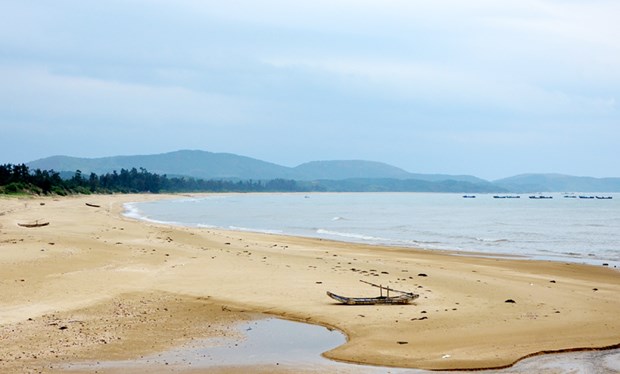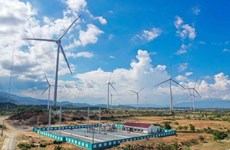Potential in Ninh Binh's coastal district needs to be wakened
 A beach in Kim Son district. (Photo:tainguyenvamoitruong.vn)
A beach in Kim Son district. (Photo:tainguyenvamoitruong.vn)Ninh Binh (VNA) – The coastal area in Kim Son district in the Red River Delta province of Ninh Binh has great development potential for different sectors, especially tourism, as it boasts charming natural landscapes and a diverse ecosystem.
The district, which is located to the southeast of Ninh Binh province and 27 km from Ninh Binh city, has nearly 19 kilometres of coastline, creating a massive ecological fringe, with an area of 105,000 ha.
Kim Son is the place where Nguyen Cong Tru (1778-1858), who was a poet, a songwriter, and an official in the Nguyen Dynasty in the early 19th century, had great merits recorded in Vietnamese history books. He gained acclaim for settling landless peasants on abandoned land. During his time of serving as "Doanh Dien Su" - an officer in charge of farms (1827-1830), he had merits in encroaching on the sea. Migrants established hamlets and built two new lands, now named Tien Hai (Thai Binh province) and Kim Son (Ninh Binh province).
Coming to Kim Son alluvial land, visitors not only admire the unique church complex - Phat Diem stone church with a unique combination of Eastern temple architecture and Gothic architecture, but also enjoy the charming natural landscapes bestowed on this land.
It is home to about 500 species of aquatic plants and animals, more than 50 species of mangroves on alluvial grounds, 200 species of birds, many of which are rare in the Vietnam Red Book, along with untouched mangrove forests, salt marshes, mudflats, and estuaries.
This ecosystem and biodiversity have made the coastal area of Kim Son an important part, and is a buffer zone and transition zone of the inter-coastal wetland world biosphere reserve in the Red River Delta recognised by UNESCO.
Con Noi island was recognised by UNESCO as a World Biosphere Reserve on December 2, 2004. The World Biosphere Reserve of the Red River Delta includes the intertidal area and mangroves forest of Kim Son, Nghia Hung, and Thai Thuy districts, Giao Thuy National Park, Con Noi Island, Vanh Island, Thu Island, Tien Hai nature reserve, and surrounding areas and Xuan Thuy Ramsar site.
Con Noi is one of the eight most important biodiversity conservation areas in the Asia-Pacific region. Coming to Con Noi in Kim Son district, visitors will be immersed in the wild and salty nature of alluvium and sea breeze. This place forms pristine beaches with potential for eco-tourism and relaxation. The district, therefore, is convenient and suitable for scientific research and ecotourism development.
With that potential and advantages, Kim Son's coastal area can strongly develop general marine economic sectors such as marine eco-tourism, resort tourism, seaport business, transportation services, aquaculture, and fishing.
For years, the Government has been investing thousands of billions of VND in building infrastructure which is expected to help boost socio-economic development in the province and connect economic development with provinces in the Red River Delta. Specifically, a sea dike system, roads linking to National Highway 10, a road leading to Con Noi island, a coastal route, Bai Dinh-Kim Son tourist route, technical infrastructure for aquaculture, storm shelters, seafood wholesale market, and electricity and irrigation systems.
However, the area has just seen small-scale aquaculture and fishing activities. The district has nearly 4,470ha of aquaculture with an output of 33,500 tonnes last year. More than 300 production facilities of clams and oysters are operating there, earning revenue of 1.5-2 billion VND (64,000 -85,300 USD) per ha per year.
 Aquaculture farm in Kim Son district. (Photo: kimson.ninhbinh.gov.vn)
Aquaculture farm in Kim Son district. (Photo: kimson.ninhbinh.gov.vn)Ninh Binh province's authorities aims to develop economic sectors in Kim Son's coastal area. The province strives that by 2030, the area of saltwater and brackish water aquaculture will reach 3,358ha; aquaculture production is expected to reach 48,400 tonnes, and aquaculture revenue rakes in 500 million VND per ha. The province also expects a mangrove forest area to increase to more than 1,400ha.
Investments are expected to be poured into developing environmentally friendly industrial parks.
Experts emphasised that the development of eco-tourism, services, and coastal trade in the locality must go hand in hand with the conservation and promotion of the value of marine resources and climate change adaptation.
Now is the time for the province to strengthen the management and implementation of planning schemes for Kim Son's coastal area. It was suggested to adopt policies and mechanisms to attract investment to build synchronous infrastructure, and sustainable development of marine space, especially transport infrastructure.
The province was also urged to complete the planting of boundary markers and demarcation of administrative management boundaries in the maritime space between Ninh Binh, and neighbouring Nam Dinh and Thanh Hoa provinces./.











